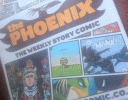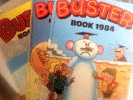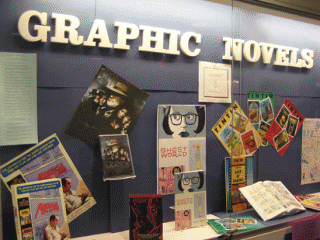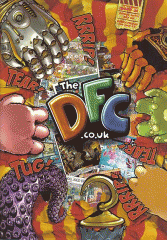Comic Books for Kids age 5 - 12






All kids love comic books, right?
Well, not me as a kid; I didn't ever read comics. I tried but couldn't "get" it. I found the stories too hard to follow, I didn't know what order to read the panels in (I can't even think how to explain it clearly!), I couldn't seem to see the clues in the pictures and sound effects (sounds usually precede dialogue in plot order). There is an art to reading comics properly (like poetry) which I didn't know. Now as an parent I find myself reading comic books quite frequently with the children, especially with Tristan (currently 6).
Isabel spent 4 months of Year2 (age 7) reading nothing but Calvin and Hobbes Anthologies (over and over, and yes, I did begin to despair). Tristan and Daniel have both been huge fans of TinTin and Asterix: they are all that six year old Tristan wants for bedtime stories and Daniel has spent much of his book token gifts on TinTin and other graphic novels. The kids read and re-read for hours Buster Annuals (dated 1983-1985) that John kept from his own youth. Now Tristan has a weekly Beano subscription (which replaced his DinoBoy habit in Dinomite). The C+H anthologies were my own, but most of these other comics I never even heard of before I had children.
Are all children's comic books the same?

Although I reckon that almost any reading is a good thing, even if mostly comics, there are some things worth knowing about in terms of supervising which comics your children delve into. Note I'm writing about modern published versions, older versions may have varied significantly.
The Adventures of Tintin
Tintin in Wikipedia
22 best-selling story books written by a Belgian artist (pen name=Hergé) from the 1930s to the 1970s, and translated into many different languages (with some cultural adaptation), these feature the world-wide adventures of the intrepid boy reporter (Tintin) and his faithful fox terrier (Snowy). Tintin is clever and courageous but quite human (not perfect). Meanwhile almost everybody else around him is somewhat foolish and the butt of many jokes. The books make the most sense if you read them in order (shown in the cover illustrations on the back of the volumes).
Things to be aware of about Tintin books:
Tintin's life is constantly in danger, he often escapes death only by some fluke event, or incompetence on the part of his adversaries. There are constant crisis points, and a great deal of threatened violence and Tintin doesn't hesitate to point guns or get into fistfights when he needs to. Guns are frequently fired in Tintin, but bullets only seem to hit the bad guys. Complicated conspiracies are the norm in Tintin and will be hard for younger children to follow. On the positive side, Tintin never bears a grudge, and he always seeks out the appropriate authorities to mete out justice to wrong-doers .
The plotlines deal with things like drug-smuggling (opium dens), and deadly commercial rivalry (people willing to kill in order to make money). Often the baddies became homicidal because of cultural offense – such as when sacred relics were stolen away.
There are a lot of racial caricatures in Tintin. The Japanese bad guys in The Blue Lotus have huge buck teeth, the native Congolese have BLACK skin with big fruffy hair, very large red lips and very large white eyes. Meanwhile, most good guys, and especially Europeans, Chinese and Indians look like ordinary people. How people speak can be also rather culturally stereotypical, eg., South American baddies speak in thick Latin accents. Nevertheless, Tintin is a model of cultural respect and polite deference to everyone he meets (regardless of any difference in racial or cultural background). He reliably stands up against injustice he encounters, which includes remonstrating with bigots, especially Europeans who treat “the natives” badly.
A main character in the later books, Captain Haddock, is a smoker and alcoholic. His fondness of whiskey is a frequent source of humour and arguably presents a too-jolly picture of alcohol addiction. Confusingly, Captain Haddock is much more of a hopeless drunk when we first meet him than in the later books. Haddock “swears” a lot, which rather than four-letter words is a stream of inventive alliterative invectives (eg., “Blistering Blue Barnacles”). I find his outbursts tedious to read.
There are no appealing female characters in Tintin, women are mostly absent from doing anything at all, much less anything interesting. The only regular character, Madame Castafiore, is more of a clown than anything else.
Asterix
Asterix and Obelix are two Frenchmen (Celts) in a village holding out against the Roman invasion in ancient Gaul. The village has a secret weapon in a magic potion that temporarily makes the village men indomitable fighters. Asterix is the little clever guy (small like a little typed Asterisk on a printed page), Obelix is his huge friend (like an enormous Obelisk). The local Roman soldiers are terrified of “the Little Gaulish Village”. The Asterix and Obelix stories (many volumes of their adventures) are enormously popular in Europe, especially (not surprisingly) among the French.
Things to be aware of about Asterix comics:
- Lots of violence, and expression of love of violence (the Gauls become morose if they haven't beaten the crud out of anyone lately). The violence is presented in a cartoon way, and nobody seems to die or be permanently injured. But still, scenes of beating people up again and again....
- Some racial caricatures, especially in the depiction of non-Europeans and different accents (similar to Tintin).
- The Romans are mostly lazy, conniving idiots. This makes for much humour, but all the achievements of ancient Rome, in art, law, engineering – don't exactly get fair coverage.
- The female characters in Asterix are very minor, They are sexy or dumpy, and are primarily engaged in petty concerns about their vanity and social status in the village community.
- The names of the characters are mostly clever tongue-twisters and puns, amusing for adult readers but a bit of a challenge for children to read and comprehend.
- The village bard is repeatedly and nastily bullied.
- Asterix is a terrific role-model in soothing over ruffled feathers and wounded egos.
Calvin and Hobbes
So much as has been written about C+H that I feel humbled in trying to say anything further. The series appeared originally as daily comic strips (3-4 panels) in American newspapers. They feature the adventures of a daft six-year-old boy (Calvin) and his stuffed tiger (Hobbes, who comes to life only for Calvin and us the readers). Hobbes operates as Calvin's conscience and later an alter-ego, expressing desires and common sense that Calvin spectacularly fails to exhibit. The series was extremely popular and the strip, which only ran for ten years, was reprinted into a large number of anthology volumes.
The early C+H strips are quite silly and slapstick, fairly standard gags. As the series aged and became wildly popular, the illustrator (Bill Waterson) produced bolder, more pointed, and more sophisticated (ironic) humour. The quality of the drawings also improves with age. Waterson managed to obtain an exception to printing conventions at the time, which basically meant that in later Sunday (colour) strips he experimented greatly with layout and presentation. Especially in later strips, the vocabulary in C+H is wide and varying (very good for literacy skills). As you would expect from a family newspaper comic strip, they contain nothing more offensive than Calvin and Hoobes having spitting contests, only very small hints of violence and certainly no swearing or sex.
Calvin is often naughty in a way that would be deeply frowned on in the real world; on the 'Net there is a very sad 3-panel C+H cartoon against ADHD-meds (produced by others, not an original by Waterson). C+H touches little on non-domestic issues or the concerns of the grown-up world (small exceptions being the stupidly of war, cyclists vs. motorists, and when his parents have to deal with a burglary). And multi-racial it ain't; Calvin lives in a very mono-cultural (all white American people) universe.
Buster
John has these, three annuals from 1983-1985. Therefore you may only find them as old volumes kicking around in the house. They are very much of their era, lots of slapstick petty violence, no female characters doing anything interesting. Boys' own adventure tales.
The Simpsons
I must declare myself a huge non-Simpsons fan, but I will endeavour to be impartial here. There are lots of published volumes containing brief sketches and episodes from this very popular American TV show. The graphic novel stories are mildly funny, contain a wide variety of cultural references and a reasonable variety of vocabulary. In many ways they tackle “adult” issues in a manageable way for children (I rate all those as good things). I am not so keen on the many references to implied violence, glorification of under-achievement, and the many in-jokes (ie, jokes that really only make sense if you've been exposed to the series for years and years – at times, reading the Simpsons stories feels like indoctrination to a cult. I also feel uncomfortable with the many blithe gags about things like mental illness, death threats and an overt celebration of unhealthy lifestyle choices. Note that I dare not link to any images of the Simpsons comics here, because their lawyers have legendary-sized fangs with regard to unpaid-for reproduction of the images.
DFC

The DFC was an independent weekly publication of multiple strips (2-5 pages per strip, 6-7 stories per issue), published in weekly volumes from 2008 to early 2009, targeted at children aged 8 to 13. The DFC was marketed as a true comic-lover's and thinking child's alternative to the likes of The Beano, with superior drawing and more detailed long-term plotlines. Daniel owns the last three months of DFCs (12 or 13 issues). The stories are often dark and convoluted, but not truly disturbing. I would seriously consider getting more of these volumes if I saw them come up for sale, best suited for age 9-13.
It has, however, made a resurrection in the form of The Phoenix.
The Beano
beano.com, magazine-group.co.uk
Tristan gets this weekly (Christmas gift from grandfather). I don't like the toys or sweets that come with each issue. The cartoon strips themselves are silly and contain petty violence. But no worse than a Warner Brothers cartoon, really. Suited to age 6-10.
Graphic novel adaptations of “real books” and similar for Primary Age children
Quite a few novels that exist in a standard book/novel format (mostly words, not pictures) have been adapted as graphic novels. Daniel especially enjoyed Artemis Fowl and Alex Rider graphic novels; mind, these are very reduced versions of the original novels (particularly with regard to vocabulary). I am glad that Dan read the real books first.
There are Star Wars graphic novel books, too – multiple short stories in a single volume, comic book format from the Episode 3/Clone Wars period in the Star Wars period. Like Star Wars Episode Three itself, these are very short on dialogue and big on pictures, violence and disturbing outcomes. Of all the graphic novel adaptations I've seen, I'd rate these as having the least merit with regard to keeping the love of reading alive.
Teenage Graphic Novels
As my eldest son approaches English High School age we have had some forays into these volumes. The main difference between these and the other volumes described here, is in explicit violence, disturbing images (like skulls with skin peeled off), and overtly sexual imagery (of females only, of course). There isn't much swearing in the teen Comics, in my experience. You need to go into the adult graphic novel genre to get four-letter-words and explicit sexual acts.
Some other comic book novels we've learnt about
Calamity Jane, Other Herge adventures

How about this comic that teaches us the importance of gas safety as well. It was inspired by a drawing from a 10 year old girl who won a children's competition run by gas safe register. Definitely worth a look: youtu.be/7tQVzhS4Tt4